US Civil Service Reforms Essay
- To find inspiration for your paper and overcome writer’s block
- As a source of information (ensure proper referencing)
- As a template for you assignment
The U.S. has undergone several civil service reforms through its history. From the Pendleton Civil Service Reform Act in 1883 that mandated that government positions should be filled according to merit rather than other criteria to lesser State reforms. In recent years, different states, including Georgia, Florida, Arizona, Colorado, and Tennessee, have been reforming their civil service policies. These reforms, in general, are aimed at making it easier to hire and retain government employees based on their merit and job performance.
These reforms also make it easier for government agencies within these states to seek the most competent employees. In a large part, this is achieved by removing protections current employees enjoy, such as seniority, and converting their positions to “at will” status. This status means that an employee can be laid off without having to find a justifiable cause for termination. The exception is illegal termination, such as that based on discrimination on the grounds of sex or religion.
Tennessee saw a major reform of its civil service in 2012, addressing the issues mentioned above. In the previous system, seniority was considered the primary criterion for employment, giving preference to more senior employees rather than ones who are more competent or suitable for the job (Barrett & Greene, 2015). The test given to applicants was described as “antiquated” and not necessarily related to the skills required by the position (Barrett & Greene, 2015). Finally, only the top 5 scorers on the test could be hired, giving preference to the most senior candidates, and thus severely limiting an agency’s hiring options (Barrett & Greene, 2015). State legislators targeted these issues with their proposed reform.
The 2012 Tennessee Excellence, Accuntability and Management (TEAM) Act sought to change that, as well as introduce other improvements to the state’s civil service system. It concerns both hiring and layoff practices, and makes civil employees’ performance easier to evaluate. Specifically, the TEAM Act requires agencies to clearly define the knowledge and skills required for each position (Tennessee Department of Financial Institutions, n. d.).
Furthermore, in case two candidates with equal qualifications are available, preference will be given to veterans (Tennessee Department of Financial Institutions, n. d.). Employees performance is now evaluated through setting specific, measurable, achievable, relevant and time-sensitive (SMART) goals, a system commonly used in private businesses (Tennessee Department of Financial Institutions, n. d.). Finally, though seniority is considered in cases of layoff, it is secondary to job performance (Tennessee Department of Financial Institutions, n. d.). These changes shift the focus in hiring, layoff, and performance evaluation practices away from seniority and towards merit and performance.
In the state of Arizona, similarly outdated civil service rules caused significant problems, highlighting why the subsequent reforms were necessary. A lack of at-will employment policies led to major complications when trying to lay off employees and an overuse of paid administrative leave within state institutions (Kelley, n. d.). Furthermore, a lack of reliable tools for performance evaluation made it difficult to determine a government employee’s competence and, therefore, decide whether to discipline or fire him or her (Kelley, n. d.). Moreover, the protections afforded to current employees made laying them off difficult even in cases where insufficient performance or disciplinary issues could be proven (Kelley, n. d.). Such issues with the previous system have prompted the state to launch its reform in 2012.
Barrett, K., & Greene, R. (2015). How Tennessee transformed the way it hires and fires people. Governing. Web.
Kelley, M. (n. d.) Civil service rules keep inept government employees on the job . Goldwater Institute. Web.
Tennessee Department of Financial Institutions. (n. d.). TEAM Act . Web.
- Human Subject’s Protection
- People With Disabilities and Social Work
- An Employee Layoff Process: Conducting the Dismissal Meeting
- Discrimination: Trans World Airlines, Inc. vs. Hardison
- Employment Termination: Ethical Management of Layoffs
- Women's Health in Correctional Settings: Addressing the Crucial Issues
- Understanding Human Rights in Australia
- Understanding of Human Rights
- Snop in Enhancing Correctional Facilities’ Services
- Anti-Transgender and Anti-LGBQ Violence Crisis in the US
- Chicago (A-D)
- Chicago (N-B)
IvyPanda. (2022, September 22). US Civil Service Reforms. https://ivypanda.com/essays/us-civil-service-reforms/
"US Civil Service Reforms." IvyPanda , 22 Sept. 2022, ivypanda.com/essays/us-civil-service-reforms/.
IvyPanda . (2022) 'US Civil Service Reforms'. 22 September.
IvyPanda . 2022. "US Civil Service Reforms." September 22, 2022. https://ivypanda.com/essays/us-civil-service-reforms/.
1. IvyPanda . "US Civil Service Reforms." September 22, 2022. https://ivypanda.com/essays/us-civil-service-reforms/.
Bibliography
IvyPanda . "US Civil Service Reforms." September 22, 2022. https://ivypanda.com/essays/us-civil-service-reforms/.
- Notice at Collection
- Your Privacy Choices
- Exercise Your Privacy Rights
- Newsletters
- 2024 Election
A National Academy of Public Administration report identified five challenges that pose substantial risks to effective government. Stephen Schildbach/Getty Images
Stay Connected


The Challenge of Modernizing the Civil Service
What has been done over the past few years to prepare the federal workforce for the 21st century virtually nothing..
Jeffrey Neal
- Civil Service
The federal civil service, with its merit-based foundation, is essential to delivery of critical services to the American people. Hiring and retaining skilled workers are essential aspects of the civil service that need immediate attention.
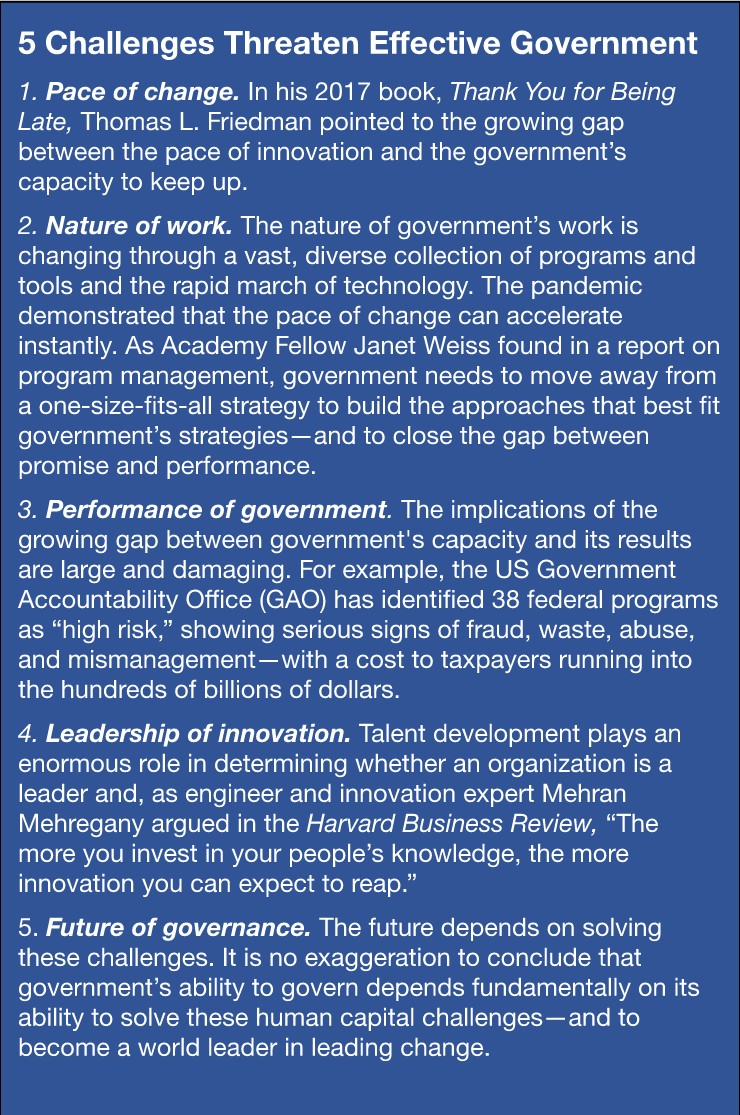
More than four years ago, the National Academy of Public Administration issued No Time to Wait, Building a Public Service for the 21st Century , a report that identified five challenges that pose substantial risks to effective government. Successfully meeting those challenges with civil service rules that are 74 years old is just not going to happen.
Building on three principles – Mission First, Principles Always, and Accountability for Both – No Time to Wait made specific recommendations to improve hiring, accountability, retention, and effectiveness of the civil service.
Sadly, we have been waiting four years and virtually nothing has been done. Partisan politics seems to make meaningful civil service reform impossible. Rather than more moderate voices on both sides of the aisle combining to lead reform, those on the extremes dominate debate.
Should there even be a debate over the size of government? Sure. But reasonable people should also agree that a government of any size must be effective for the American people.
Calls for civil service reform are not new. Everyone knows that the federal hiring processes are a nightmare that no one would deliberately design. The process is so miserable that it appears to be designed to see how desperately an applicant wants to work for the government. Government pay is equally opaque, and the combination of a byzantine hiring process and inflexible pay make it difficult for the government to recruit top talent, especially in high demand occupations. There is also a widespread belief that agencies neither adequately reward high performers, nor deal effectively with poor performers. Even common-sense solutions that could satisfy most reasonable people have not made their way through the politics and bureaucracy.
So why does common sense not prevail? Why does a system that many believe simply does not meet the challenges of a 21st century workplace continue without significant change? Discussions with interested parties typically lead to the same result – interest groups agree reform is necessary, but partisan and interest group differences lead to widely diverging solutions. Most groups insist their favorite aspects of the existing rules must remain untouched. There is no consensus on specific changes that would comprise comprehensive civil service reform.
Tackling Critical Issues to Address the Most Compelling Federal Workforce Challenges
A working group of Fellows of the National Academy of Public Administration, with government HR and management expertise, including former career and political executives, concluded that proposing a comprehensive reform of the civil service would be futile. Instead, the group decided to adopt a targeted approach to modernization that focuses on issues of broad agreement that could address the hiring, pay and accountability issues that comprise the biggest weaknesses in the civil service.
Over the coming four months, the Academy will release a series of white papers that address these challenges and our recommendations. We will start with the Merit System and the future of work, and the reasons that a merit-based civil service is essential for a federal government that serves the needs of the people. Next we will bring our recommendations on hiring, along with a proposal (including specific legislative language) to modernize veterans’ preference in a way that dramatically simplifies federal hiring while providing more employment and advancement opportunities for Veterans.
In the third installment we will address pay and job classification, with specific legislative language that would speed the adoption of modern pay practices and provide agencies with more tools to compete effectively for talent in the rapidly evolving 21st century workplace. In May we will address accountability, including the questionable data comparing federal employee and private sector accountability, and the challenges of rewarding good performers and dealing effectively with poor performance.
We believe we must balance the compelling need for modernization with the political realities. We will propose reforms that can gain acceptance across a broad spectrum of interest groups that are active in civil service issues, along with bipartisan support in Congress. We cannot wait until the government faces a crisis without the talent to solve it – that will be too late.
Jeffrey Neal, f ormer chief human capital officer for the U.S. Department of Homeland Security, is a Fellow of the National Academy of Public Administration.
NEXT STORY: USPS Opens a New Line of Credit With Treasury
Help us tailor content specifically for you:

U.S. Government Accountability Office
Marking 40 Years with the Civil Service Reform Act
Last month marked a milestone in the history of the country’s federal personnel system. Forty years ago on October 13, the Civil Service Reform Act (CSRA) was landmark legislation and it continues to serve as the foundation for much of the present personnel system governing federal workers. Today’s WatchBlog explores what we have found about its implementation through the years and opportunities that lie ahead.
What is the Civil Service Reform Act?
The CSRA significantly changed how the federal government manages its workforce. For example, it replaced the Civil Service Commission with the Office of Personnel Management (OPM). It also enacted nine merit system principles designed to improve the quality of public service by, among other actions, recruiting employees from all segments of society, providing equal pay for work of equal value, and retaining and separating employees on the basis of their performance. Further, the CSRA also established a Senior Executive Service so government would have competent executives.
Shortly after it was enacted, we reported on OPM’s progress implementing the CSRA and noted that despite reforms, the civil service system was still viewed as burdensome, outdated, overregulated, and inflexible. Over the years, we have recommended numerous actions OPM should take to strengthen federal personnel management.
What Are More Recent Issues?
Fast forward to today: we believe that key personnel functions still need to be modernized. Since CSRA was enacted, the federal workforce has changed to include many more white collar jobs requiring complex analytical thinking skills. In light of these changes, in 2008 we reported on additional efforts needed in human capital planning, diversity management, and OPM leadership.
In 2014, we reported that the General Schedule (GS)—the government’s classification system for defining and organizing federal positions—had not kept pace with the government’s evolving requirements. Modernizing it would help the government have the right people at the right place, at the right time, and in the right numbers to address complex national challenges.
What’s Needed in the Future?
Since 2014, we have made a number of priority recommendations to OPM that address broader government-wide reforms. For example, we recommended that the government use prior studies and lessons learned to examine ways to make the GS system’s design and implementation more consistent with the attributes of a modern, effective classification system.
Meanwhile, federal agencies can take some actions on their own to improve how they manage their workforce. Implementing our leading practices in human capital management is a good place to start. We have also made recommendations to address and close skills gaps within specific federal agencies as well across the federal government.
Recently, we highlighted how agencies already have the authority to make changes but often are not taking advantage of that authority. In 2016, we found that many federal agencies were using relatively few available hiring authorities. A hiring authority is the law, executive order, or regulation that allows an agency to hire a person into the federal civil service. Agencies used 105 hiring authorities in fiscal year 2014, but relied on 20 of them for nearly all new hires.

Earlier this year, we blogged about how federal agencies may also provide special payments in certain circumstances to hire people with needed critical skills. Our report found that in 2016, federal managers were seldom using these special payments, such as retention and relocation incentives or student loan repayments.
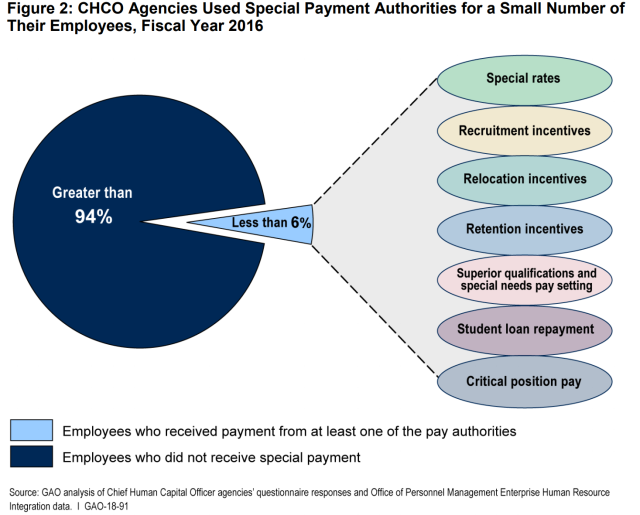
Another change that would support the federal workforce would be to reexamine the way that federal employees are hired and paid. Last year, we testified that it is important for agencies to make better use of the tools already at their disposal, such as using more flexibility in their hiring practices. Acting on our findings could significantly improve the government’s personnel management system and help agencies better carry out their missions.
We will continue to monitor both broader government-wide efforts at implementing CSRA as well as to present opportunities for agencies to improve their human capital management to ensure they are consistent with the spirit of the CSRA.
- Comments on GAO’s WatchBlog? Contact [email protected] .
GAO Contacts
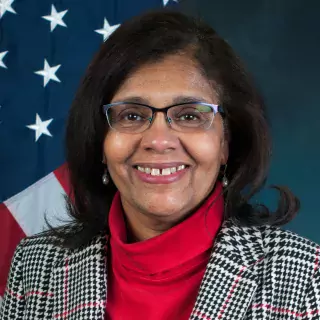
Related Posts

Prioritizing the Needs of the Federal IT Workforce

Racial Disparities in Federal Employment, Lending, and Housing

The Secret Service's IT Workforce
Related products, federal hiring: opm needs to improve management and oversight of hiring authorities, product number, federal pay: opportunities exist to enhance strategic use of special payments, civil service reform--where it stands today, human capital: transforming federal recruiting and hiring efforts, human capital: opm needs to improve the design, management, and oversight of the federal classification system, federal workforce: recent trends in federal civilian employment and compensation, human capital: key principles for effective strategic workforce planning, federal workforce: opm and agencies need to strengthen efforts to identify and close mission-critical skills gaps, federal workforce: sustained attention to human capital leading practices can help improve agency performance.

GAO's mission is to provide Congress with fact-based, nonpartisan information that can help improve federal government performance and ensure accountability for the benefit of the American people. GAO launched its WatchBlog in January, 2014, as part of its continuing effort to reach its audiences—Congress and the American people—where they are currently looking for information.
The blog format allows GAO to provide a little more context about its work than it can offer on its other social media platforms. Posts will tie GAO work to current events and the news; show how GAO’s work is affecting agencies or legislation; highlight reports, testimonies, and issue areas where GAO does work; and provide information about GAO itself, among other things.
Please send any feedback on GAO's WatchBlog to [email protected] .
Stanford University

Center on Democracy, Development and the Rule of Law is housed in the Freeman Spogli Institute for International Studies
Stanford Scholar Issues Call to Action to Protect and Reform the U.S. Civil Service
- Nora Sulots
Francis Fukuyama , Olivier Nomellini Senior Fellow at Stanford University’s Freeman Spogli Institute for International Studies, is leading an effort to protect and reform the U.S. public service. He has organized a Working Group to Protect and Reform the Civil Service in response to plans elaborated in the Heritage Foundation's Project 2025 to strip civil service protections from all federal workers and replace them with political loyalists in a future administration.
The Need for Reform
A group of nonpartisan experts and scholars recently convened at the National Academy of Public Administration to discuss civil service reform. This discussion is critical in light of plans to revive "Schedule F," an executive order that would reclassify many federal positions, remove civil service protections, and allow political loyalty to dictate hiring and firing.
A Better Vision
The Working Group proposes an alternative vision for a more effective federal workforce based on five principles:
Agility: Modernizing outdated systems to adapt to technological, economic, and social changes.
Accountability: Ensuring federal employees remain loyal to the Constitution while being responsive to elected officials.
Collaboration: Leveraging skills and knowledge across various sectors, including private industries and universities.
Outcomes: Focusing on producing real-world results valued by the public and simplifying government procedures.
Capacity: Providing federal workers with the skills, training, and education needed to fulfill their missions effectively.
Risks of “Schedule F”
Reviving “Schedule F” would undermine these goals, promoting politicization over merit-based results. Government workers might avoid necessary risks and innovation if judged on political loyalty. The Working Group plans to detail further how the federal government can evolve to meet these challenges and become a 21st-century government.
Fukuyama and the Working Group call for support in protecting and reforming the civil service to ensure a competent, non-partisan, and effective federal workforce. Click here to read their statement in full.
Francis Fukuyama Honored with Lifetime Achievement Award
Reimagining public policy education at stanford and beyond.
The six government reforms we need in 2021
Subscribe to governance weekly, paul c. light paul c. light nonresident senior fellow - governance studies.
October 14, 2020
This post is part of a series on the need for government reform and how to get it done. For more on this topic, visit the series page .
If Joe Biden is elected president and the federal government is to meet rising public concerns for faithful execution, he must make reform part of his agenda. It is one thing for him to promise a twenty-first-century government that is open and competent, as so many candidates have over the years. It is quite another to offer specifics on the size and cause of problems and provide a clear list of possible solutions that might help the government deliver on presidential promises. Consider five commitments toward that goal. And while these ideas are more likely to be implemented under a Biden administration—given President Trump’s disinterest in such approaches during his first four years—the same ideas would be useful if the president were reelected and opted to shift dramatically in his approach to a government reform agenda.
1. Expand the make-government-work-for-the-people plan to include government performance
Biden’s campaign and lobbying reforms are unlikely to affect day-to-day government performance unless he commits to deep bureaucratic repairs. Americans agree that campaign spending is too high and special interests too strong, but the way to make government work for the people is to give it the resources and authority to do the job well. Biden should also promise to eliminate the backlog of high-risk problems that continue to undermine federal performance, while reinforcing and extending the Obama administration’s commitment to evidence-based policymaking.
2. Reinforce the ethics system to protect against deceit
Dismantlers and rebuilders are more likely than other Americans to believe that special interests run the country, and they blame both parties for the horror stories about members of Congress and presidential aides who engage in misconduct. They know the legislative process is broken and want it fixed. Call it worse than it looks , worse than you think , or even the worst of the worst , the two groups want an end to insider dealing and the gridlock it produces. They also want effective federal oversight offices, starting with the Office of Government Ethics and Offices of Inspector General.
3. Reinvent government, again by streamlining the organization chart
The Biden campaign can find a perfect outline of how to reinvent government again at the University of West Texas “cyber-cemetery.” That is where Gore’s reinventing government papers are archived. Although Gore’s reinventors made significant progress in their first few years, the campaign slowed down with Clinton’s fall from grace.
Gore’s long-running reform campaign was widely caricatured at the time as a paradise for bureaucratic wonks and dreamers, but it generated an impressive list of impacts. “We cut government the right way by eliminating what wasn’t needed,” says Gore’s top reinventing aide, Elaine Kamarck , of the bloated hierarchies, duplication, obsolete field offices, needless regulations, and antiquated systems that grew the kudzu strangling federal innovation and productivity. Kamarck endorsed another round of reinventing early in Trump’s first term: “It is time to review the government again and ask the hard questions about what it’s doing and what it should be doing. And it is time to focus on obsolete functions and getting rid of them.” She is right.
4. Squash the Plum Book
Most presidential appointees are fully committed to faithfully executing the laws, but their growing numbers create opportunities for misconduct and inefficiency. Biden would do well to swear off the traditional addiction to political plums by promising to eliminate half of the “at-will” positions currently listed in the leadership directories (commonly referred to as the Plum Book). Doing so would draw a sharp contrast with the Trump administration’s use of every available slot to enforce party discipline deep into the federal hierarchy.
Along the way, Biden should demand a head-to-head inventory of the workforce—how else to manage it? [1] Congress and the president could call on the U.S. Office of Personnel Management for detailed information on every employee in the government, including hiring dates, promotions, job switches, and performance evaluation; however, that would only be part of the battle. They would still have no idea about the employees who show up to work under contracts and grants.
5. Rebuild the public service
The past two years have been especially punishing for the federal public service, and not just because of the shutdown in the winter of 2018–19. As former Federal Reserve Board Chairman and founder of the Volcker Alliance, Paul A. Volcker and I argued soon after that shutdown ended, the federal workforce needs immediate action as its workforce ages and the competition for talent increases:
Congress and the president must repair the federal government’s outdated personnel system. It has been forty years since Congress and President Carter inked the last major civil service reform, and the ossification is taking its toll on productivity and retention.
- Congress and the president must reassure young Americans that the federal government is a good place to work. The millennials and Gen Zs are not saying “show me the money” but rather, “show me the impact.”
- Democrats and Republicans must work to restore “regular order” in the federal budgeting process. There will always be an element of brinksmanship and uncertainty associated with the appropriations process, but the use of shutdown budgeting must end.
- Biden must honor the federal government’s pledge to fund the Public Service Loan Forgiveness Program by addressing continued mismanagement at the Department of Education.
- Congress and the president must make implementation a bigger issue in the policy process. As long as our leaders work to design and enact “high policy” such as the Affordable Care Act and immigration reform, they devote negligible attention to the nut and bolts of action. [2]
Volcker dedicated his life to calling the nation’s best and brightest to public service. It is the perfect time for Biden to start drafting a law built around Paul A. Volcker’s long commitment to public service reform. Naming a statute for the chairman of two historic national commissions on public service would not just honor promises to make government work for the people, it would encourage Americans to give the federal government the chance to regain their trust.
6. Try Common Sense
If vision without execution is hallucination, as Mr. Volcker often said, execution without vision is bureaucratic sloth. As public administration scholar Philip K. Howard contends, effective government flourishes with policies based on the human capacity to make appropriate decisions for the public good. Instead of relying on “bureaucratic verbiage,” Howard urges the federal government to embrace a “new operating philosophy built on the bedrock of individual responsibility and accountability.” [3]
Acknowledgments: I am grateful to my research team and many colleagues for their help in collecting, analyzing, and interpreting the data presented in this report. Of special note are my colleagues at New York University, especially my lead research scientist in the effort, Jie Ding, the survey team at SSRS, Nick Taborek at Nation Analytics, John Hudak, Christine Stenglein and my many colleagues at the Brookings Institution Center for Effective Public Management, and the Volcker Alliance team that shepherded so much of my past work on the topics presented here.
[1] The need for careful accounting was highlighted by then Rep. Chris Van Hollen (D-MD) in late 2014 in a tense House Budget Committee meeting as the committee began debating a cut in the number of federal employees. Pushed forward by the Association of Federal Government Employees (AFGE), Van Hollen asked the Congressional Budget Office enlighten the debate by providing a side-by-side analysis of budget savings from reductions in the number of federal and contractors: “I ask that when future reports include options to reduce the number of federal employees that they also consider options to achieve savings in the contracted workforce. This would allow Congress to consider tradeoffs between all aspects of government operations.” CBO refused the request, noting that it was unaware of any comprehensive database that contained the information, which was why Van Hollen asked the agency to build it. This exchange was summarized in an AFGE newsletter on December 11, 2014 .
It is useful to note that the methodologies used to generate estimates of contract and grant employment for this report had already been tested in a 2006 report from my Organizational Performance Initiative. See Paul C. Light, “The New True Size of Government,” The Organizational Performance Initiative, New York University, Robert F. Wagner School of Public Service, August 2006.
[2] Americans showed strong support for the public service during the historical government shutdown in late 2018, but have long viewed government as a good place to work and often cited as positives the pay, job security, chance to make a difference, and helping people in need. Moreover, when asked whether they would like to see their child pursue a career in government, roughly half of Americans endorse the choice. Not surprisingly, dismantlers have been the most likely to answer “no” to that question over the years, while streamliners, rebuilders, and expanders have been more favorable. In 2016, for example, 66 percent of dismantlers said “no,” while 45 percent of streamliners, 52 percent of rebuilders, and 65 percent of expanders said “yes.” For the recent trend line on this question, see the Pew Research Center’s 2015 survey, Beyond Distrust , page 42. According to Pew, support for a career in government rose from 43 percent in 1997 to 56 percent in 2010 before dropping to 48 percent in 2015. My 2016 survey showed a further drop to 44 percent, a move that was likely a response to polarization surrounding the 2016 campaign.
[3] Philip K. Howard, Try Common Sense: Replacing the Failed Ideologies of Right and Left , (New York: W.W. Norton, 2019), 161.
Related Books
Donald F. Kettl
September 1, 1998
James L. Sundquist Hedrick Smith
November 1, 1995
Paul C. Light
November 1, 1999
Related Content
September 23, 2020
Elaine Kamarck
January 24, 2017
Governance Studies
Center for Effective Public Management
The Katzmann Initiative on Improving Interbranch Relations and Government
Linda Peek Schacht
August 29, 2024
Russell Wheeler, Benjamin Wittes, Kathryn Dunn Tenpas
Zachary Billot, Annie Vong, Nicole Dias Del Valle, Emily Markovich Morris
August 26, 2024
- DOI: 10.1111/PUAR.12075
- Corpus ID: 56206138
The Rise and Fall of Radical Civil Service Reform in the U.S. States
- Robert J. McGrath
- Published 1 July 2013
- Political Science
- Public Administration Review
Figures and Tables from this paper

18 Citations
Are we there yet the state of public human resource management research, the privatization of the public workplace, public sector employment at will: a critical analysis of ethical concerns and recommendations for public administrators, getting ahead in the public sector, public service in times of politicized crisis: how combatting covid-19 reveals threats to merit principles, administrative values and public personnel management.
- Highly Influenced
Divided government, delegation, and civil service reform
Contracting, ethics, and policy adoption: the case of florida municipalities, experts, amateurs, and the politics of delegation in the american states, safeguarding the public trust: teaching organizational dissent in an era of political polarization, 65 references, civil service reform the state and local response, personnel reform in the states: a look at progress fifteen years after the winter commission, civil service reform in georgia.
- Highly Influential
Civil Service Reform
American public service: radical reform and the merit system, thinking the unthinkable in public administration, civil service reform, at-will employment, and george santayana: are we condemned to repeat the past, the future of merit: twenty years after the civil service reform act, assessing the temporary use of at-will employment for reorganization and workforce reduction in mississippi state government, a return to spoils revisiting radical civil service reform in the united states, related papers.
Showing 1 through 3 of 0 Related Papers
- Work & Careers
- Life & Arts
Tensions rise between civil service and ministers globally, study shows
To read this article for free, register now.
Once registered, you can: • Read free articles • Get our Editor's Digest and other newsletters • Follow topics and set up personalised events • Access Alphaville: our popular markets and finance blog
Explore more offers.
Then $75 per month. Complete digital access to quality FT journalism. Cancel anytime during your trial.
FT Digital Edition
Today's FT newspaper for easy reading on any device. This does not include ft.com or FT App access.
- Global news & analysis
- Expert opinion
Standard Digital
Essential digital access to quality FT journalism on any device. Pay a year upfront and save 20%.
- FT App on Android & iOS
- FT Edit app
- FirstFT: the day's biggest stories
- 20+ curated newsletters
- Follow topics & set alerts with myFT
- FT Videos & Podcasts
Terms & Conditions apply
Explore our full range of subscriptions.
Why the ft.
See why over a million readers pay to read the Financial Times.
This site uses cookies to optimize functionality and give you the best possible experience. If you continue to navigate this website beyond this page, cookies will be placed on your browser. To learn more about cookies, click here .
- Skip to primary navigation
- Skip to main content
- Skip to primary sidebar
UPSC Coaching, Study Materials, and Mock Exams
Enroll in ClearIAS UPSC Coaching Join Now Log In
Call us: +91-9605741000
Civil Service Reforms
Last updated on October 15, 2023 by ClearIAS Team

Bureaucracy in India evolved during the British Raj. It worked to promote British interests until 1947. After Independence Indian bureaucracy was entrusted with the critical responsibility of nation-building. After Independence, The bureaucracy worked satisfactorily until it started wilting gradually.
Table of Contents
Some Observations About Civil Services In India
The following are some of the observations of the 2nd Administrative Reforms Commission .
- In India, the civil service is more focused on internal procedures than on outcomes.
- The policy and management structures within which the public service performs are excessively complicated and frequently too constricting due to systemic rigidities, unnecessary complexities, and over-centralization.
- In order for a decision to be made, many veto points must be resolved due to the hierarchical nature of the structures.
- Effective governance with an emphasis on decentralization and citizen-centricity must replace the preeminence of governance.
Constitutional provisions related to Civil Services
- As per Articles 53 and 154 , the executive power of the Union and the States vests in the President or Governor directly or through officers subordinate to him. These officers constitute the permanent civil service and are governed by Part XIV of the Constitution (Services under the Union and States ( Article 308- 323 )).
- Government of India (Transaction of Business) Rules : The manner in which the officers are required to help the President or Governor to exercise his/her executive functions is governed by these Rules.
- Article 309: Powers of Parliament and state legislatures – It empowers the Parliament and the State legislature regulates the recruitment, and conditions of service of persons appointed, to public services and posts in connection with the affairs of the Union or of any State respectively.
- Article 310: Doctrine of Pleasure – Every person of Defence service, Civil Service and All India Service holding any post connected with the above services holds office during the pleasure of the President or Governor of the State.
- Article 311: Dismissal, removal, or reduction in rank.
- Article 311 – Dismissal, removal, or reduction in rank of persons employed in civil capacities under the Union or a State.
- Article 312 – All India Services.
- Article 323A: Administrative Tribunals
Required Civil Service Reforms
The following reforms have been suggested by the 2nd ARC
- Stage of Entry : Bachelor’s degree programs in public administration, governance, and management will be offered by the National Institute of Public Administration. Assistance should also be provided to certain Central and other universities so they can offer graduate-level programs in certain subjects. Graduates from other fields would also be qualified to sit for the Civil Services Examination if they successfully complete a “Bridge Course” in the aforementioned basic areas.
- Disciplinary Proceedings : In the event of disciplinary proceedings, contact with the UPSC should only be required in circumstances where a government employee’s dismissal or removal is likely.
- Training and capacity building : Every government employee should go through required induction training as well as recurrent training throughout their career. For confirmation in service and subsequent promotions, successful completion of these training should be a minimum requirement.
- Performance Management System : Enhancing the collaborative and transparent nature of appraisal, customizing the formats for individual jobs, and transforming the current performance appraisal system for employees into a full-fledged performance management system (PMS).
Recommendation of some other committees.
- Examining candidates in a common subject as opposed to optional subjects was preferred by the Civil Services Examination Review Committee, 2001 (headed by Professor Yoginder K. Alagh) .
- The Hota Committee Report , 2004, made recommendations for the introduction of aptitude and leadership exams for selection as well as for giving probationers one month after the start of training to exercise their option for services.
- The Basawan Committee (2016) advised doing a genuine assessment of the need for IAS officers annually in order to make the government a realistic request for Direct Recruits each year and to keep track of the openings below the promotion ceiling.
- Three mid-career training programmes should be offered during the 12th, 20th, and 28th years of service, according to the Yugandhar Committee’s 2003 recommendation. At these three points in the officer’s career, there is a “significant transition” in the nature of their work, hence training was recommended.
- Information and communication technology (ICT) may be used to alter government by making it more accessible, efficient, and responsible, according to the Hota Committee of 2004.
Certain recommendations like lateral entry into civil services need to be scrutinized meticulously. Timely upgradation of the capabilities of the steel frame is necessary to ensure national integrity.
Related article: Civil Service Reforms During British
UPSC CSE 2025: Study Plan ⇓
(1) ⇒ UPSC 2025: Prelims cum Mains
(2) ⇒ UPSC 2025: Prelims Test Series
(3) ⇒ UPSC 2025: CSAT
Note: To know more about ClearIAS Courses (Online/Offline) and the most effective study plan, you can call ClearIAS Mentors at +91-9605741000, +91-9656621000, or +91-9656731000.
Article Written by: Vivek Rajasekharan

Top 10 Best-Selling ClearIAS Courses
Upsc prelims cum mains (pcm) gs course: unbeatable batch 2025 (online), rs.75000 rs.29000, upsc prelims marks booster + 2025 (online), rs.19999 rs.14999, upsc prelims test series (pts) 2025 (online), rs.9999 rs.4999, csat course 2025 (online), current affairs course 2025 (online), ncert foundation course (online), essay writing course for upsc cse (online), ethics course for upsc cse (online), upsc interview marks booster course (online), rs.9999 rs.4999.


About ClearIAS Team
ClearIAS is one of the most trusted learning platforms in India for UPSC preparation. Around 1 million aspirants learn from the ClearIAS every month.
Our courses and training methods are different from traditional coaching. We give special emphasis on smart work and personal mentorship. Many UPSC toppers thank ClearIAS for our role in their success.
Download the ClearIAS mobile apps now to supplement your self-study efforts with ClearIAS smart-study training.
Reader Interactions
Leave a reply cancel reply.
Your email address will not be published. Required fields are marked *
Don’t lose out without playing the right game!
Follow the ClearIAS Prelims cum Mains (PCM) Integrated Approach.
Join ClearIAS PCM Course Now
UPSC Online Preparation
- Union Public Service Commission (UPSC)
- Indian Administrative Service (IAS)
- Indian Police Service (IPS)
- IAS Exam Eligibility
- UPSC Free Study Materials
- UPSC Exam Guidance
- UPSC Prelims Test Series
- UPSC Syllabus
- UPSC Online
- UPSC Prelims
- UPSC Interview
- UPSC Toppers
- UPSC Previous Year Qns
- UPSC Age Calculator
- UPSC Calendar 2024
- About ClearIAS
- ClearIAS Programs
- ClearIAS Fee Structure
- IAS Coaching
- UPSC Coaching
- UPSC Online Coaching
- ClearIAS Blog
- Important Updates
- Announcements
- Book Review
- ClearIAS App
- Work with us
- Advertise with us
- Privacy Policy
- Terms and Conditions
- Talk to Your Mentor
Featured on

and many more...
ClearIAS Programs: Admissions Open
Thank You 🙌
UPSC CSE 2025: Study Plan
Subscribe ClearIAS YouTube Channel

Get free study materials. Don’t miss ClearIAS updates.
Subscribe Now
IAS/IPS/IFS Online Coaching: Target CSE 2025

Cover the entire syllabus of UPSC CSE Prelims and Mains systematically.

Civil Service Reform

Civil Service Reform Timeline
Strategic components, read essays, civil service reform research, news & stories, introduction.
A capable, motivated civil service is the backbone of good governance and quality public service provision. A high-performing government requires employees who are well-trained and educated, fairly compensated, and effectively managed.
That is why the administration of Governor Pedro R. Pierluisi and the Financial Oversight and Management Board for Puerto Rico have made deliberate, strategic investments in a comprehensive Civil Service Reform (CSR) to improve governance and operational capacity across all agencies to strengthen and improve the way government works for the people. The CSR focuses on improving the experiences of public servants, so that they can professionally grow in their careers, learn through improved training, have a more positive work experience and, in turn, feel more motivated to transform their departments and provide the best services to Puerto Rico residents.
The Civil Service Reform
The civil service reform pilot.
Given the administrative challenge of implementing a reform as comprehensive and complex as the CSR, a pilot approach has been adopted. Implementing small-scale pilots enables the government to test a complex reform before determining whether and how to implement it across all agencies. This approach fosters consensus-building and the identification of best practices, paving the way for a more effective implementation across all government agencies. A pilot project also allows the government to maximize success by analyzing a smaller-scale implementation of the reform and fine-tuning the reform program, identifying administrative and technical pitfalls that need to be addressed before a broader implementation.
The first CSR pilot program focused on accounting, finance, and IT departments at the Department of Treasury (Hacienda) and the Office of Management and Budget (OGP), spanning from July 2021 to September 2022. It encompassed salary adjustments for 76% of employees, proposed 112 new positions, reclassified 93 employees, and introduced skills-based evaluations, with 75% of employees expressing confidence in the system’s effectiveness.
In March 2024, a second CSR pilot program was launched to transform talent acquisition and management processes, with a focus on recruiting over 200 positions, including accountants, data scientists, and engineers, and testing an innovative skills-based talent management strategy. Further details regarding these pilot programs are outlined below.
Civil Service Reform Strategic Components
Organizational design, employee evaluation.

Compensation
Recruitment, civil service reform key accomplishments.

1st CSR Pilot in the Department of Treasury and the Office of Management and Budget
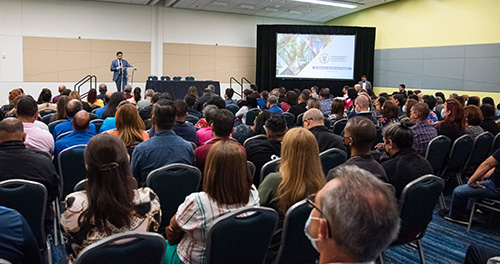
Successfully completed in September 2022, the first CSR pilot program was initiated in accounting, finance, and IT sectors at the Department of Treasury (Hacienda) and the Office of Management and Budget (OGP) in July 2021, due to the human capital challenges in public financial management and the importance of the timely publication of audited financial reports. As part of the pilot in Hacienda and OGP, 76% of in scope pilot employees received a salary adjustment at a cost of $2.6 million to ensure competitive salaries using a data-driven, market-based approach, 112 new positions for recruitment were recommended after the development of new organizational structures (e.g., a Center for Government Excellence in OGP and a Center for Customer Service in Hacienda), 93 employees were reclassified, and 98% of supervisors completed a skills-based evaluation of their employees. According to a survey, 75% of pilot employees expressed confidence in the effectiveness of the new skills-based employee evaluation system for identifying skill gaps.
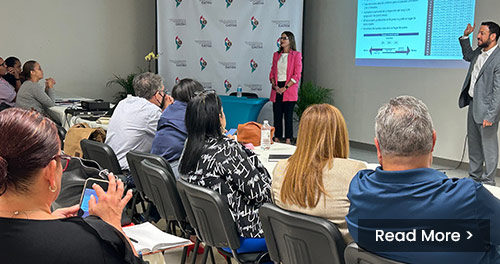
Implementation of a New Uniform Classification and Remuneration Plan of the Central Government:
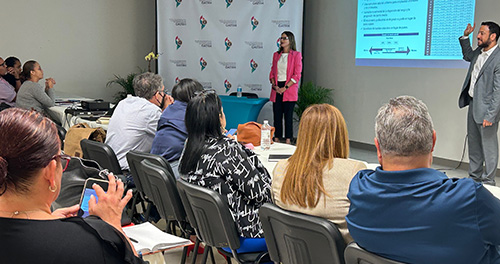
A new Uniform Classification and Remuneration Plan was implemented, retroactive to January 1, 2023, which establishes the base salary for employees working in central government agencies. It is the first time the government has used a data-driven, market-based methodology for competitive, fair and fiscally responsible salaries. The new compensation plan impacted approximately 55% of the close to 23,000 URP employees and brought the current salary of incumbent employees to the minimum of their respective new salary scales and employees with “hot jobs” to the midpoint of the scales. These salary adjustments resulted in an annual recurrent cost of $104.7 million, marking a 14% increase in the annual payroll expenditure.

Talent Acquisition and Talent Management CSR Pilot
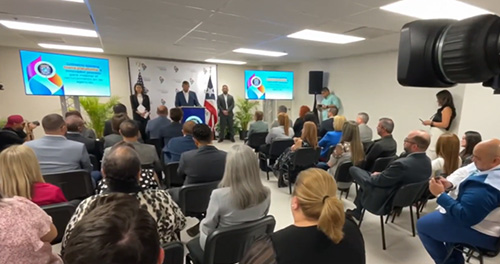
In March 2024, the Government of Puerto Rico launched a new and innovative pilot plan that seeks to reform talent acquisition and talent management processes using artificial intelligence. This pilot will undergo evaluation to allow for adjustments before its application to the entire government. These new processes have been developed to ensure the government has an agile and flexible recruitment system to attract and retain the best talent. The agencies participating in the pilot are the Office of Management and Budget (OGP), Department of Treasury (Hacienda), Office of Administration and Transformation of Human Resources of the Government of Puerto Rico (OATRH), Department of Economic Development and Commerce (DDEC), Institute of Forensic Sciences (ICF), Puerto Rico Innovation and Technology Service (PRITS), and the Department of Education (PRDE). In total, the Government will be recruiting more than 200 positions through this new pilot process, including accountants, data scientists, public policy analysts, information system specialists, budget and purchasing analysts, engineers and project managers for the permitting area. This Pilot Plan also includes a new skills-based talent management strategy focused on maximizing the development growth opportunities of employees over time. With this, Puerto Rico becomes the first state and local public sector jurisdiction in the US, and one of the first in the world, to formally introduce a skills-based talent acquisition and talent management strategy using artificial intelligence.

Civil Service Reform at the Department of Education

Given the success of the CSR within the central government, the Puerto Rico Department of Education (PRDE) requested to be added even though it is not covered by Act 8-2017, to improve the experience of the public servants at PRDE through the transformation of human resources. PRDE is undergoing broader CSR to build capacity among personnel (beginning with finance and accounting functions) to have a better back-office structure that supports the education system. The implementation of the CSR at PRDE impacts the following 10 organizational areas: Budget, Federal Funds (OFA), Finance, Office for Public School Improvement (OMEP), Payroll, School Food Authority (AEA), Purchasing, Associate Secretary for Special Education, IT (OSIATD), and the State Agency for Food and Nutrition Services (AESAN).
Civil Service Reform Timeline by Phases
Planning and Implementation of the New Uniform Classification and Remuneration Plan: October 2022- March 2023
Design of the Future Recruitment Process, Talent Management, and Related Elements. July 2023 – March 2024
Civil Service Reform Clips

The CSR's goal is to improve the services the Department of Education provides
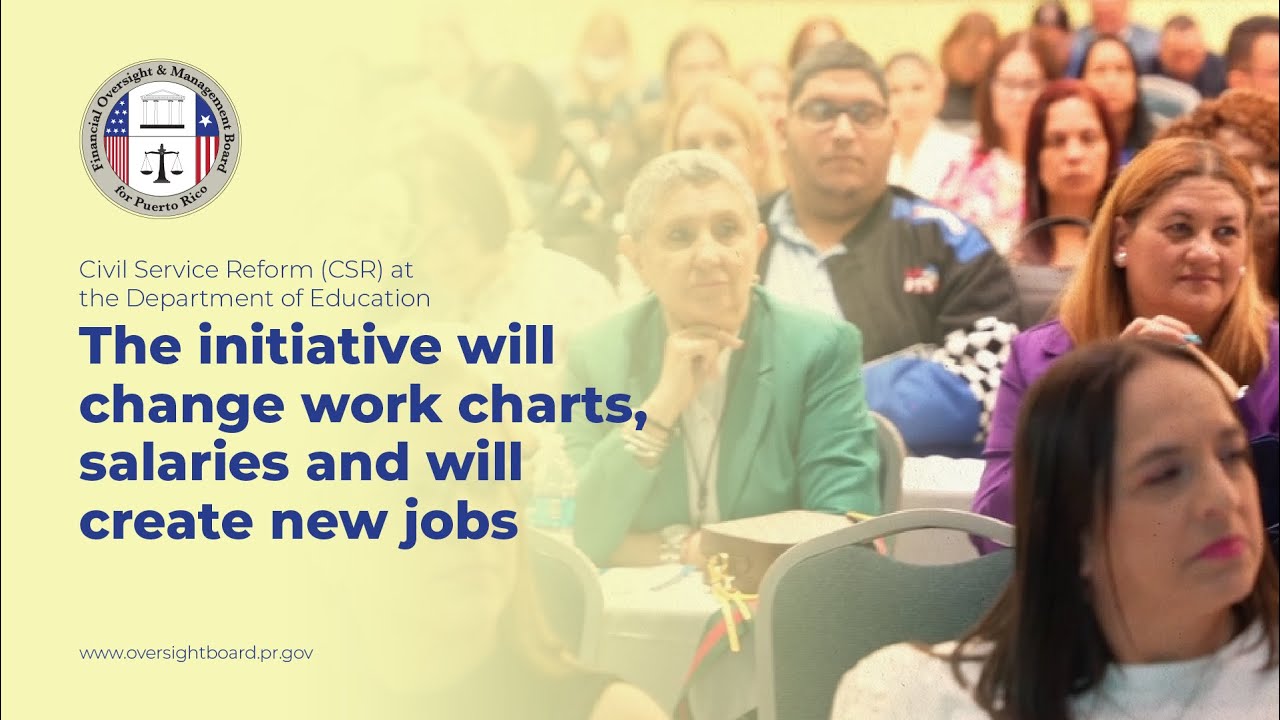
The initiative will change work charts, salaries and will create new jobs
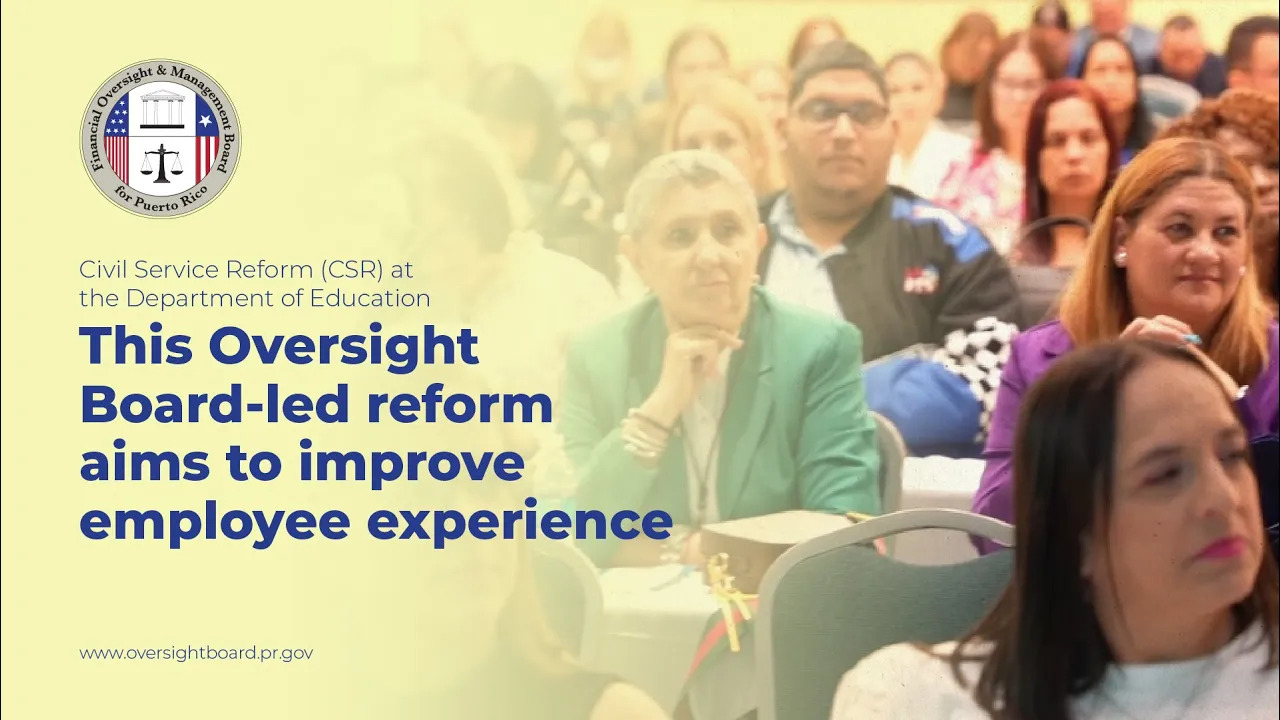
This Oversight Board-led reform aims to improve employee experience
Testimonials.

“We have collaborated with the Financial Oversight and Management Board for Puerto Rico in developing the pilot project that began at the Puerto Rico Treasury Department and the Office of Management and Budget. Our objective is to keep the valuable personnel we have and, at the same time, attract new talent to public service in Puerto Rico.”
Lcda. Zahira A. Maldonado Molina
OATRH Director
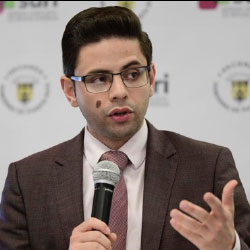
“This is an ambitious Civil Service Reform, with the implementation of the pilot project being only the beginning, and it requires the commitment of every one of us in the government. I put my trust in my working team and the results we have gotten today anticipate a positive future for the agency.”
Francisco Parés Alicea
Former Treasury Secretary

“We are confident that this reform will yield significant benefits for all components of the government, especially those workers who will receive economic compensation comparable to the private sector. We will also create new positions and bring more efficient services to citizens.”
Lcdo. Juan Carlos Blanco
OGP Director

“Today marks the first time in 25 years that salary scales and classifications have been revised and adjusted to reflect the capabilities and experience of Puerto Rico’s governmental employees. This is a historic moment for the Government of Puerto Rico, and we are proud to be a part of such success.”
David A. Skeel Jr
Former Chairman of the FOMB
Blog A Modern Civil Service
https://moderncivilservice.blog.gov.uk/2024/08/28/techtrack-start-a-new-career-in-tech/
TechTrack: Start a new career in tech
Did you know, you can start a new career in tech at any stage of your working life? TechTrack is a new digital upskilling programme, delivered via an apprenticeship and created by the Government Digital and Data Profession. This community of experts leads digital transformation in government and is on a mission to build skills at scale. TechTrack is open to everyone and aims to springboard civil servants into a wide range of digital roles.

Delivering world-class technology
Government Digital and Data’s tech projects are all part of government's roadmap to transform public services and deliver world-class technology. UK citizens rightly have an expectation to access public services easily and TechTrack will play a key part in this, through upskilling and building digital talent. Leveraging the power of digital and data will make government more productive and sustainable, with less duplication and waste.

Is TechTrack for me?
You may be aware of the significant and growing skills gap in digital, data and technology capabilities across the Civil Service. TechTrack aims to find, train and retain this digital talent in key roles, ensuring sustainable support for government departments and embedding these skills into the Civil Service for the long term.
Along with addressing this skills gap, TechTrack will implement a digital recruitment experience that reduces time to hire and supports a reduction in our reliance on contingent labour. These digital apprenticeships will accelerate the realisation of a more diverse and inclusive workforce through improved attraction and recruitment processes.
Which roles are on offer?
The programme launched at the end of July and offers uniquely tailored apprenticeships in four of the most sought after digital roles across government including software developer, DevOps engineer, business analyst and cybersecurity technologist (risk)
Applications for the first cohort are now open for the two developer roles and you can find out more and apply here . Applications close on 29 August 2024. You can also sign up to be informed when applications open for the next cohort for these two roles.
Applications for business analysts and cybersecurity roles will open in autumn.
Who can apply?
The programme is open to everyone. You might be an existing civil servant seeking a new career path or want to gain specific qualifications to support your career journey.
The apprenticeship starts at Higher Executive Officer level (HEO). If you are not at HEO level but feel you have the right skills and experience, please apply. If you are currently at Senior Executive Officer (SEO) level or above, you can still apply, however please check the terms and conditions of the job offer when applications open.
You can hear from a current apprentice software developer , Dale Bellamy about choosing an apprenticeship and switching his career from sales to digital.

If you are a department or talent lead, you can find out more and bid to hire TechTrack apprentices on our bespoke platform . You can also sign up for information sessions and request a meeting with the TechTrack team on the same platform.
Find out more about TechTrack .
Tags: #ProudCivilServant , A Modern Civil Service , Capability , careers , Change , Civil Service Learning , data science , government digital and data
Sharing and comments
Share this page, leave a comment.
Cancel reply
By submitting a comment you understand it may be published on this public website. Please read our privacy notice to see how the GOV.UK blogging platform handles your information.
Related content and links
- A Modern Civil Service hub
- A Modern Civil Service news
- Blog comments and moderation guidelines
Sign up and manage updates
Cries of cronyism over Wes Streeting’s former Labour aide landing key Civil Service job
Appointment fuels calls for independent investigation as Tories object to party loyalists being parachuted into ‘impartial’ Whitehall roles

The Government is facing fresh claims of cronyism after it emerged that a former member of Wes Streeting ’s staff has been given a Civil Service role.
The official, who worked for Mr Streeting, the Health Secretary, when Labour was in opposition, has been hired to a communications job in the Department of Health.
It comes as Sir Keir Starmer faces growing questions over the number of party loyalists being parachuted into supposedly impartial Whitehall roles.
The Tories have called for an independent investigation into the allegations and suggested the appointments are a power grab orchestrated by Sue Gray .
Many of the appointments have been made using an exceptions rule which allows ministers to circumnavigate the usual Civil Service recruitment process.

Rules drawn up by the Civil Service Commission say they should only use the process for short-term hires or where “highly specialist skills” are required.
The latest example involves an official who worked for Mr Streeting before the election. Shortly after Labour won power, he took a job in the Department of Health.
It is unclear whether he had to go through the full recruitment process, including an interview, or if he was hired under the exceptions rule.
The revelations will add to growing allegations of cronyism in the Government that are threatening to erupt into a Downing Street sleaze scandal.
Sir Keir has attempted to dismiss the allegations as Tory smears, but the appointments have also been criticised by independent experts.
The cronyism row began when it emerged Rachel Reeves , the Chancellor, had appointed a Labour donor to a senior Civil Service role in the Treasury.

Ian Corfield , who gave more than £20,000, was made a director of investment but has given up the job to become an unpaid adviser following an outcry.
That was followed by Emily Middleton , a businesswoman whose firm donated £67,000 to the party, being made a director-general in the science department.
Jess Sargeant, who worked for a pro-Starmer think tank, has also been handed a senior role in the Cabinet Office’s Propriety and Constitution Group, which is responsible for ensuring the highest standards of propriety and ethics across all government departments.
Sir Keir is also facing questions over the decision to hand Lord Alli, a leading Labour donor , a much sought-after security pass to No 10.
A Department of Health and Social spokesman said: “The department does not comment on individual personnel matters. Any appointments are made in line with the Civil Service rules on recruitment.”
- Wes Streeting,
- Labour Party,
- Keir Starmer,
- Conservative Party
- Facebook Icon
- WhatsApp Icon

IMAGES
VIDEO
COMMENTS
The U.S. has undergone several civil service reforms through its history. From the Pendleton Civil Service Reform Act in 1883 that mandated that government positions should be filled according to merit rather than other criteria to lesser State reforms. In recent years, different states, including Georgia, Florida, Arizona, Colorado, and ...
All were accomplished during that summer 40 years ago after intricate horse-trading among lawmakers of both parties, an ambitious and prescriptive president, long-time civil servants, labor unions ...
The Government of Puerto Rico and Oversight Board are working on a Civil Service Reform to build a more efficient, effective, and accountable government and creating an improved work experience for public sector employees. ... The first essay focuses on three main topics: Chronicle of the reform, from the initial stage of investigation and ...
February 13, 2023. Civil Service. The federal civil service, with its merit-based foundation, is essential to delivery of critical services to the American people. Hiring and retaining skilled ...
tions about New York.212.3 Civil Service Reform Movement and the Pendleton Act of 1883While pressure for the adoption of a merit reform had been mounting since the 1860s (Hoogen-boo. , 1968), the exact timing of the passing of the Pendleton act is related to two events. First, in July of 1881, President James.
Last month marked a milestone in the history of the country's federal personnel system. Forty years ago on October 13, the Civil Service Reform Act (CSRA) was landmark legislation and it continues to serve as the foundation for much of the present personnel system governing federal workers. Today's WatchBlog explores what we have found about its implementation through the years and ...
Civil service reform is one of the most intractable yet important challenges for governments and their supporters today. It touches not only on governments very purpose for existence but also on some of its most sensitive, '. protected areas. The civil service is the backbone of the state, supporting or undermining the entire system of ...
Francis Fukuyama, Olivier Nomellini Senior Fellow at Stanford University's Freeman Spogli Institute for International Studies, is leading an effort to protect and reform the U.S. public service.He has organized a Working Group to Protect and Reform the Civil Service in response to plans elaborated in the Heritage Foundation's Project 2025 to strip civil service protections from all federal ...
Civil service reform in the United States was a major issue in the late 19th century at the national level, and in the early 20th century at the state level. Proponents denounced the distribution of government offices—the "spoils"—by the winners of elections to their supporters as corrupt and inefficient. They demanded nonpartisan ...
Essays: Civil Service Reform A New Data-Driven, Market-Based Compensation Philosophy and Salary Structure for Competitive, Fair, and Equitable Salaries in the Government of Puerto Rico" Date: March 27, 2023 Download essay In February, a new uniform salary structure was implemented which establishes the base salary for employees working in central government agencies. Since the implementation ...
By Marc Boyd. December 23, 2022. Nearly 45 years after President Carter signed the landmark Civil Service Reform Act of 1978, the work of perfecting a meritocratic, non-partisan and appropriately compensated federal civil service is unfinished. But the legacy of the CSRA as (for now) the final major overhaul of the federal workforce is undeniable.
civil service reform was minimizing the role of the state. This phase also brought unintended results, and since the late 1990s donors have focused on promoting accountable systems whose leaders understand and support the reforms they are implementing. Civil service reform is just one aspect of the broader topic of public administration (or
The reform will also foster a high-performing, competent, and supported public workforce. Stay tuned for the essay's publication: Civil Service Reform: A New Data-Driven, Market-Based Compensation Philosophy and Salary Structure for Competitive, Fair, and Equitable Salaries in the Government of Puerto Rico
As the spoils system became entrenched, its deleterious effects on the civil service appeared. The movement to reform the civil service arose during the struggle over reconstructing the Union. With peace and Lincoln's assassination, the Reconstruction of the Union was of paramount concern. Hayes and his administration's limited reform measures ...
1. Expand the make-government-work-for-the-people plan to include government performance. Biden's campaign and lobbying reforms are unlikely to affect day-to-day government performance unless he ...
Initiated by a 1996 Georgia statute, "radical" civil service reform quickly swept the United States. This article explains the wax and eventual wane of state efforts to increase the number of at-will employees at the expense of the population of fully protected merit system employees. Using an event history approach to explain this policy diffusion with state-level variables, the author ...
O'Halloran 1999). In contrast to all these papers, I take the existence of both bureau-crats and politicians as given, and ask about the effect of civil service rules on the choices of politicians. Civil service reform is studied theoretically in Ujhelyi (20 1 2) . That paper explains
Civil servants around the world are increasingly suffering strained relationships with ministers as conflicts over providing quick-fix solutions and serving long-term national interests rise ...
Essay: Towards A Stronger Civil Service - Creating A Culture Of Accountability In Public Sector Performance. Government officials have continued to focus mainly on salary increases to reform civil service and bolster improvements in the government's capacity to address 21st century challenges and needs.
The main factors. include the big siz e of the public service, low levels of professionalism, poor qualifications, and. lack of institutional Capacity in the public service. The main process of ...
Daily Updates of the Latest Projects & Documents. This document is being processed or is not available. This report has three aims: 1) to describe the shape and evolution of the civil service of the Philippines; 2) to document past and current attempts at civil service .
Related article: Civil Service Reforms During British. UPSC CSE 2025: Study Plan ⇓. (1) ⇒ UPSC 2025: Prelims cum Mains. (2) ⇒ UPSC 2025: Prelims Test Series. (3) ⇒ UPSC 2025: CSAT. Note: To know more about ClearIAS Courses (Online/Offline) and the most effective study plan, you can call ClearIAS Mentors at +91-9605741000, +91-9656621000 ...
Civil Service Reform Civil Service Reform Timeline Strategic Components Videos Read Essays Civil Service Reform Research News & Stories Introduction A capable, motivated civil service is the backbone of good governance and quality public service provision. A high-performing government requires employees who are well-trained and educated, fairly compensated, and effectively managed. That is why ...
P. Tjiptoherijanto/Civil Service Reform in the Philippines 3 of the civil service. Civil service reform e orts were minimal during the presidential tenures of Fidel Ramos (1992-1998) and Joseph Estrada (1998-2001). President Ramos simply focused on giving life to the concept of new public management (NPM) with the end goal of reengineering the
You may be aware of the significant and growing skills gap in digital, data and technology capabilities across the Civil Service. TechTrack aims to find, train and retain this digital talent in key roles, ensuring sustainable support for government departments and embedding these skills into the Civil Service for the long term.
The Government is facing fresh claims of cronyism after it emerged that a former member of Wes Streeting's staff has been given a Civil Service role.. The official, who worked for Mr Streeting ...